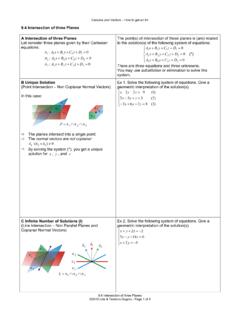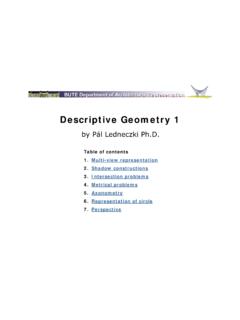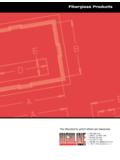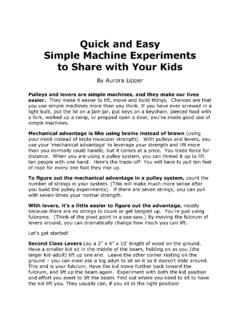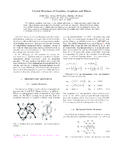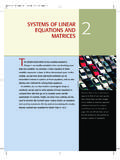Transcription of DEFINITION OF QUANTITIES EVALUATED BY WAMIT
1 Chapter4 DEFINITION OF QUANTITIESEVALUATED BY WAMITThe forces and other QUANTITIES EVALUATED by WAMIT are output in a standard nondi-mensional form, in terms of the appropriate combinations of the water density , theacceleration of gravityg, the incident-wave amplitudeA, frequency ,and the length scaleLdefined by the input parameter ULEN in the GDF file. (The volume and coordinates ofthe center of buoyancy are exceptions. They are output in a dimensional form.)Body motions and forces are defined in relation to the origin of the same Cartesiancoordinate system relative to which the panel offsets are defined. Note that this originmay be located on, above or below the free planes of symmetry are defined forthe body, the origin must always lie on these planes of symmetry. Thex- andy-axes mustbe parallel to the mean position of the free notation and definitions of physical QUANTITIES here correspond with those in Ref-erence [3], except that in the latter reference theyaxis is of the EVALUATED QUANTITIES are included with appropriate identification in the OUToutput file.
2 To facilitate post-processing the same QUANTITIES are also saved in the numericoutput files, following the format defined in Section the cases of field data and mean drift forces (Options 5-9) the definitions given belowin Sections apply to the complete solution for the combined radiation and diffractionproblems. The same QUANTITIES can be EVALUATED separately for either the radiation ordiffraction problems, as explained in Section the sake of simplicity, the definitions which follow in this Section assume that theorigin of the coordinate system is located on the free surface. Special definitions apply tosome QUANTITIES if vertical walls are defined, as explained in Section HYDROSTATIC DATAAll hydrostatic data can be expressed in the form of surface integrals over the mean bodywetted surfaceSb, by virtue of Gauss divergence ) Volume = Sbn1xdS= Sbn2ydS= Sbn3zdSAll three forms of the volume are EVALUATED in WAMIT , as independent checks of thepanel coordinates, and printed in the summary header of the output file.
3 The medianvolume of the three is used for the internal computations. If it is less than 10 30,awarning is displayed and the coordinates of the center of buoyancy are set equal to bottom-mounted structures, where panels are not defined on the bottom, the lastintegral defined above differs from the correct submerged volume as noted in Section ) Coordinates of center of buoyancyxb= 12 Sbn1x2dSyb= 12 Sbn2y2dSzb= 12 Sbn3z2dSc) Matrix of hydrostatic and gravitational restoring coefficientsC(3,3) = g Sbn3dS C(3,3) =C(3,3)/ gL2C(3,4) = g Sbyn3dS C(3,4) =C(3,4)/ gL3C(3,5) = g Sbxn3dS C(3,5) =C(3,5)/ gL3C(4,4) = g Sby2n3dS+ g zb mgzg C(4,4) =C(4,4)/ gL4C(4,5) = g Sbxyn3dS C(4,5) =C(4,5)/ gL4C(4,6) = g xb+mgxg C(4,6) =C(4,6)/ gL4C(5,5) = g Sbx2n3dS+ g zb mgzg C(5,5) =C(5,5)/ gL4C(5,6) = g yb+mgyg C(5,6) =C(5,6)/ gL4whereC(i, j)=C(j, i) for alli, j, except forC(4,6) andC(5,6).
4 For all other values ofthe indicesi, j,C(i, j)= particular,C(6,4) =C(6,5) = C(4,4), C(4,6), C(5,5) and C(5,6),mdenotes the body mass. When Alternativeform 1 is used for the FRC file (Section ) the body mass is computed from the relationm= . When Alternative form 2 is used for the FRC file (Section ) the body mass isdefined by EXMASS(3,3).4 ADDED-MASS AND DAMPING COEFFICIENTSAij i Bij= Sbni jdS Aij=Aij Lk Bij=Bij Lk .wherek= 3 fori, j=1,2,3,k= 4 fori=1,2,3,j=4,5,6ori=4,5,6,j=1,2,3 andk= 5 fori, j=4,5, EXCITING FORCESa) Exciting forces from the Haskind relationsXi= i Sb(ni 0 i 0 n)dSb) Exciting forces from direct integration of hydrodynamic pressureXi= i Sbni DdS Xi=Xi gALm,wherem= 2 fori=1,2,3 andm= 3 fori=4,5, BODY MOTIONS IN WAVESTwo alternative procedures are followed to evaluate the body motions in waves, corre-sponding respectively to the Alternative 1 (Section ) and Alternative 2 (Section )FRC control Alternative 1, which is restricted to a body in free stable flotation without externalconstraints, the following relations holdm= xb=xg,yb=ygwheremis the body mass and (xg,yg,zg) are the coordinates of the center of 3 The inertia matrix is defined as m000mzg myg0m0 mzg0mxg00mmyg mxg00 mzgmygI11I12I13mzg0 mxgI21I22I23 mygmxg0I31I32I33.
5 ( ) WAMIT equates the body mass to the mass of the displaced water in free flotation. Themoments of inertiaIijare defined in terms of the corresponding radii of gyrationrij, definedby the relationIij= rij|rij|.The array XPRDCT(I,J) input to WAMIT contains the radii of gyration input with thesame units of length as the length scale ULEN defined in the panel data the Alternative 2 format of the FRC file the matricesMij+MEij,BEijandCEijareinput by the user to include the possibility of external force/moment constraints acting onthe complex amplitudes of the body s motions jare obtained from the solution of the6 6 linear system, obtained by applying Newton s law6 j=1[ 2(Mij+MEij+Aij)+i (Bij+BEi,j)+(Cij+CEij)] j= the matricesMEij,BEijandCEijare included only in the Alternative 2 case. Note thatin the Alternative 2 case the user must specify the body inertia matrixMijand include itin the total inertia matrixMij+MEijspecified in the FRC non-dimensional definitions of the body motions are i= iA/Ln,wheren= 0 fori=1,2,3 andn= 1 fori=4,5,6.
6 The rotational motions ( 4, 5, 6) aremeasured in HYDRODYNAMIC PRESSUREThe complex unsteady hydrodynamic pressure on the body boundary or in the fluid domainis related to the velocity potential by the linearized Bernoulli equationp= total velocity potential is defined by = D+i 6 j=1 j j,where the radiation and diffraction velocity potentials are defined in Section In orderto render the velocity potential and the hydrodynamic pressure non-dimensional, we define p=p gA= D+KL6 j=1 j 2/gand D= DigA/ , j= jLn+1withn= 0 forj=1,2,3 andn= 1 fori=4,5, body pressure can be EVALUATED separately for the diffraction or radiation problemsby following the procedure described in Section When the radiation components areoutput separately, the nondimensional pressure due tojth mode is defined by p=p g jLn=KL jor p=p ajLn+1= jwhereajis the acceleration in the same unit as the gravitional constant specified in theGDF file forj=1,2,3 and the angular acceleration inrad/s2forj=4,5, 0 forj=1,2,3 andn= 1 forj=4,5, FREE-SURFACE ELEVATIONThe free surface elevation is obtained from the dynamic free-surface condition = 1g( t)z=0,and in non-dimensional form4 5 = A= D+KL6 j=1 j j z=0,where is defined as in Section [Note that the non-dimensional field hydrodynamicpressure and wave elevation are equal to the non-dimensional velocity potential at therespective positions.]
7 ]These parameters can be EVALUATED separately for the diffraction or radiation problemsby following the procedure described in Section When the radiation components areoutput separately, the nondimensional free-surface elevation due tojth mode is defined by = jLn=KL jwheren= 0 forj=1,2,3 andn= 1 forj=4,5, evaluation of the pressure or free-surface elevation requires special caution closeto the body surface. Within a distance on the order of the dimensions of the adjacentpanel(s), field-point QUANTITIES cannot be computed reliably. More specific limits can beascertained by performing a sequence of computations and studying the continuity of theresult. Approaching the body along a line normal to the centroid of a panel will minimizethis problem. See Reference [12] regarding the computation of run-up at the intersectionof the body and free VELOCITY VECTOR ON THE BODY AND IN THE FLUIDDOMAINThe non-dimensional velocities EVALUATED by WAMIT are defined in vector form by V=VigA/( L)= D+KL6 j=1 j jwhere =L is the non-dimensional gradient parameters can be EVALUATED separately for the diffraction or radiation problemsby following the procedure described in Section evaluation of the velocity requires special caution close to the body surface, in thesame manner as the pressure and free-surface elevation.
8 (See Section above.) Whenthe radiation components are output separately, the nondimensional velocity due tojthmode is defined by4 6 V=VvjLn= jwherevjdenotes the velocity of the body forj=1,2,3 and the angular velocity forj=4,5, 0 forj=1,2,3 andn= 1 forj=4,5, MEAN DRIFT FORCE AND MOMENTThe DEFINITION of the non-dimensional mean drift force and moment in unidirectional wavesis Fi=Fi gA2 Lkwherek= 1 for the forces (i=1,2,3), andk= 2 for the moments (i=4,5,6).For bi-directional waves of the same period, with complex amplitudes (A1,A2) andcorresponding angles of incidence ( 1, 2), the nondimensional outputs Fi( 1, 2) are thecoefficients such that the total dimensional mean drift force or moment exerted on thebody is given by the equationFi( 1, 2)= gLk(|A1|2 Fi( 1, 1)+|A2|2 Fi( 2, 2)+2Re[A1A 2 Fi( 1, 2)])Note that F i( 2, 1)= Fi( 1, 2), where the asterisk ( ) denotes the complex Option 8, the evaluation of the horizontal drift force and vertical moment is basedon the momentum conservation principle in its general form (see References [4] and [26]),without the assumption of energy conservation.
9 This permits the analysis of cases wherethe body motions are affected by non-conservative effects, such as external damping. Theazimuthal integration required to evaluate the momentum flux is performed by an adaptivequadrature formula in subroutine MDRFTM. The integration is performed iteratively, withconvergence specified by the criterion of absolute or relative errors in each drift force lessthan TOL=10 4. The maximum number of iterations is controlled by the parameterMAXMIT. A warning message is displayed in the event that this convergence criterionis not satisfied. See Section for further information regarding the interpretation andcontrol of this warning the warning message is issued because the length scale parameter ULEN is muchsmaller than the relevant length scale of the body. Since the drift force increases in pro-portion to length, and the moment in proportion to (length)2, relatively small differencesbetween large values may not be significant.
10 In this case the warning message can beavoided by increasing ULEN to a value more representative of the force or moment can be either converged for most practical purposes or too small tobe important in practice. It is recommended to check the practical importance of this quan-tity. Further check on the convergence of the result can be made by increasing MAXMIT4 7gradually. Since the computational time increases exponentially, it is not recommended touse significantly large MAXMIT than the default Option 9, the evaluation of the drift force and moment is based on integration ofthe pressure over the body surface, using the relations in [10] and [17], as summarized inSection When ICTRSURF=1 the drift force and moment are also EVALUATED basedon the momentum flux across a control surface, using equations ( ).The mean drift force and moment EVALUATED from momentum conservation, in Option 8,are defined with respect to the global coordinate system.
